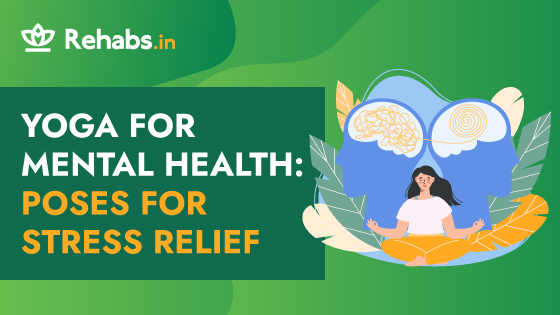Yoga for Mental Health: Poses for Stress Relief

In today’s frenetic pace, yoga emerges as a vital sanctuary for mental health. Its fusion of movement, breath, and mindfulness forms a powerful antidote to stress. Through deliberate poses and meditation, yoga reduces cortisol levels, easing tension and anxiety. It nurtures resilience, enhancing clarity and emotional balance. This ancient practice not only strengthens the body but also cultivates a profound connection between mind and spirit. Its holistic approach addresses the roots of stress, fostering tranquillity and promoting mental clarity in a world where peace is often elusive.
In our modern hustle, stress has become an unwelcome companion, affecting mental well-being profoundly. Studies reveal its prevalence, with a significant percentage experiencing stress-related symptoms. The relentless pressure disrupts mental equilibrium, contributing to anxiety, depression, and experiencing burnout at work. Chronic stress hijacks focus impairs decision-making, and weakens resilience.
This article aims to uncover yoga’s prowess as a stress-management tool, delving into its multifaceted benefits for mental well-being. By elucidating the science behind yoga’s stress-relief mechanisms, it offers a comprehensive guide to leveraging specific poses. Emphasising practicality, it details effective yoga postures proven to alleviate stress, accompanied by simple yet powerful techniques to maximise their impact.
Understanding Stress and Its Impact
Stress is the body’s response to any demand or pressure, whether positive or negative. It’s a natural reaction designed to help cope with challenges, often triggering a “fight or flight” response. Here are some of the physiological and psychological effects of stress:
Physiological Effects:
- Hormonal Surge: Release of cortisol and adrenaline heightens alertness but can lead to long-term health issues.
- Increased Heart Rate: Acceleration of heart rate and blood pressure.
- Muscle Tension: Stiffness due to the body preparing for action.
- Suppressed Immune System: Long-term stress weakens the immune system, making one more susceptible to illness.
Psychological Effects:
- Anxiety and Worry: Persistent stress can manifest as generalised anxiety or specific worries.
- Mood Swings: Fluctuations in emotions, potentially leading to irritability or mood disorders.
- Cognitive Impact: Difficulty concentrating, memory issues, and reduced decision-making abilities.
- Behavioural Changes: Changes in sleep patterns, eating habits, or social withdrawal.
Addressing stress is paramount for optimal mental health as it directly influences emotional well-being. Unmanaged stress amplifies the risk of anxiety, depression, and various mental health conditions. Chronic stress alters brain chemistry, impacting mood regulation and cognitive functions. It undermines resilience, making coping with life’s challenges more arduous.
Holistic approaches like yoga offer multifaceted benefits in stress management. They integrate physical movement, controlled breathing, and mindfulness, fostering a harmonious connection between mind and body. Yoga reduces cortisol levels, calming the nervous system and alleviating physical tension. Its emphasis on mindfulness cultivates awareness, promoting a present-centred focus that mitigates rumination and anxiety.
The Science of Yoga and Stress Relief
Yoga practices soothe the nervous system, like a gentle hug calming a busy mind. When we do yoga, slow breathing and gentle movements signal our brain to relax. This tells the body to lower stress hormones like cortisol, making us feel calmer. It’s like a switch turning down the body’s ‘alert’ mode. This calming effect helps muscles relax, eases tension, and slows down racing thoughts. Yoga also boosts feel-good chemicals in our brains, making us feel happier and less stressed.
Mindfulness cultivates present-moment awareness, anchoring attention away from stressors, reducing rumination, and fostering a calmer perspective. Breath control serves as a bridge between the mind and body, activating the body’s relaxation response, easing tension, and calming the nervous system. Relaxation techniques, like progressive muscle relaxation or guided imagery, induce a state of calm, alleviating physical and mental stress.
Studies indicate that practising yoga might enhance overall well-being by reducing stress, bolstering healthy habits, and enhancing mental and emotional health, sleep quality, and balance. It’s shown potential in alleviating neck pain, migraines, tension headaches, and discomfort linked to knee osteoarthritis.
Basic Yoga Poses for Stress Relief
- Child’s Pose (Balasana): Kneel, then sit back on your heels, extending your arms forward with your forehead resting on the mat. Breathe deeply, feeling a gentle stretch through your back.
Video guide for Child’s pose (Balasana)
- Cat-Cow Stretch: Start on all fours, arch your back upward while inhaling (cow pose), then round your spine while exhaling (cat pose). Repeat this fluid movement several times, syncing breath with movement.
Video guide for Cat-Cow Stretch
- Standing Forward Fold (Uttanasana): From standing, bend forward at the hips, allowing your upper body to hang loose. Let gravity release tension in your neck and shoulders.
Video guide for Standing Forward Fold (Uttanasana)
- Seated Forward Bend (Paschimottanasana): Sit on the floor, legs stretched forward. Hinge at the hips to fold forward, reaching for your feet or shins, feeling a gentle stretch along the back of your legs and spine.
Video guide for Seated Forward Bend (Paschimottanasana)
- Legs-Up-The-Wall Pose (Viparita Karani): Lie on your back with legs extended up against a wall. Relax and focus on deep breathing, letting go of tension in the legs and lower back.
Video guide for Legs-Up-The-Wall Pose (Viparita Karani)
- Corpse Pose (Savasana): Lie flat on your back, arms by your sides, palms facing up. Close your eyes and focus on relaxing each part of your body systematically while deepening your breath.
Video guide for Corpse Pose (Savasana)
Intermediate Yoga Poses for Deeper Stress Reduction
Basic yoga poses focus on foundational movements, introducing gentle stretches and relaxation. Intermediate poses build upon these foundations, deepening stretches, incorporating balance, and engaging core strength. They require increased flexibility and body awareness, gradually advancing practitioners toward more intricate postures for enhanced relaxation and stress relief.
- Bridge Pose (Setu Bandhasana): Lie on your back, bend your knees, and lift your hips while pressing your feet and arms into the mat. This pose helps open the chest and release tension in the spine.
Video guide for Bridge Pose (Setu Bandhasana)
- Extended Triangle Pose (Utthita Trikonasana): Stand with legs wide apart and reach one arm down to your ankle or shin while extending the other arm up toward the sky. This pose stretches the sides of the body and promotes relaxation.
Video guide for Extended Triangle Pose (Utthita Trikonasana)
- Seated Forward Bend (Paschimottanasana) Variation with Twist: From a seated forward bend, add a gentle twist by reaching one arm across to the opposite leg, deepening the stretch and releasing tension in the spine.
Video guide for Seated Forward Bend (Paschimottanasana)
- Cow Face Pose (Gomukhasana) Arms: Sitting comfortably, stack one knee over the other, then reach one arm up and the other behind your back, trying to clasp hands. This shoulder-opening pose helps release upper body tension.
Video guide for Cow Face Pose (Gomukhasana) Arms
- Reclining Bound Angle Pose (Supta Baddha Konasana): Lie on your back, bring the soles of your feet together, and let your knees fall gently to the sides. This restorative pose opens the hips and promotes relaxation.
Video guide for Reclining Bound Angle Pose (Supta Baddha Konasana)
- Eagle Pose (Garudasana): Stand tall, cross one thigh over the other, then wrap the opposite arm under and around, aiming to bring palms together. This balancing pose relieves tension in the shoulders and hips while improving focus.
Video guide for Eagle Pose (Garudasana)
Consistent practice forms the bedrock of progress in yoga, nurturing familiarity with poses and deepening their effects. Gradual advancement ensures safety, allowing the body to adapt, preventing injury, and refining alignment. This steady approach cultivates strength, flexibility, and mindfulness, facilitating a sustainable and fulfilling yoga journey.
Advanced Yoga Poses and Mind-Body Connection
Advanced yoga practices involve heightened self-awareness, encouraging practitioners to delve into emotions and sensations held within the body. Through intricate poses and deep breathing, practitioners confront and release emotional tension stored in muscles, fostering profound emotional release and self-discovery, facilitating holistic stress relief.
- Shoulder Stand (Sarvangasana): From lying down, lift your legs and torso, supporting your lower back with your hands. This pose stimulates the thyroid gland and calms the nervous system.
Video guide for Shoulder Stand (Sarvangasana)
- Headstand (Sirsasana): Balancing your head with arms supporting, this inversion increases blood flow to the brain, promoting mental clarity and reducing stress.
Video guide for Headstand (Sirsasana)
- Plow Pose (Halasana): From the Shoulder Stand, lower your feet behind your head, touching the ground. This pose stretches the spine and shoulders and calms the mind.
Video guide for Plow Pose (Halasana)
- Fish Pose (Matsyasana): Lying on your back, arch your upper back and lift your chest while supporting your weight with your elbows. This opens the chest, relieving tension and anxiety.
Video guide for Fish Pose (Matsyasana)
- Extended Hand-to-Big-Toe Pose (Utthita Hasta Padangusthasana): Stand, grab a big toe, and extend your leg forward. This balance poses challenges to focus and stability, calming the mind.
Video guide for Extended Hand-to-Big-Toe Pose (Utthita Hasta Padangusthasana)
- Firefly Pose (Tittibhasana): This arm balance involves lifting the body off the ground with legs extended. It strengthens the core, promoting mental resilience and focus.
Video guide for Firefly Pose (Tittibhasana)
Approach advanced poses with caution, honouring individual limits and seeking guidance from experienced instructors. Gradually build strength and flexibility, respecting the body’s signals. Incorrect alignment or forceful attempts can lead to injury. Prioritise safety, listen to your body and progress mindfully under expert supervision for a fulfilling practice.
Tips for a Successful Yoga Practice
Consistency nurtures progress in any practice, including yoga, fostering growth and proficiency over time. Patience cultivates resilience, acknowledging that improvement takes time. Self-compassion allows for mistakes, embracing the journey with kindness, nurturing a positive relationship with oneself amidst challenges and accomplishments. Along with yoga, it is also essential to focus on nutrition. Your diet can improve your mental health.
- Choose a Quiet Space: Opt for a peaceful area at home or a serene studio conducive to focus and relaxation.
- Invest in a Yoga Mat: Get a quality mat for comfort and stability during poses.
- Wear Comfortable Clothing: Pick breathable, stretchy attire allowing free movement.
- Start with Basic Poses: Begin with foundational poses like Downward Dog or Child’s Pose to build confidence.
- Follow Online Tutorials: Use beginner-friendly videos or apps for guidance.
- Practice Regularly: Aim for consistency over duration, gradually increasing practice time.
- Listen to Your Body: Respect limitations, avoid forcing poses, and focus on proper alignment.
- Breathe Mindfully: Sync breath with movement for a more mindful practice.
- Consider a Beginner’s Class: Join a class for personalised guidance and community support.
Yoga and Mental Health Resources
Here are some websites and apps where you can learn yoga online:
- Asana Rebel: Get in shape
- Yogaia: Daily yoga and workout
- Cult.fit
- Alo Moves
- Chelsey Corus
- CorePower Yoga
- Elena Browser
Yoga can also help people struggling with addition or if you’re managing your stress as a caregiver. Several rehabilitation centres in India incorporate yoga as a holistic approach to addiction recovery. To discover residential facilities focusing on yoga teachings, click here.
Sources:
Howard, M. (2023, February 23). The 20 Best Yoga Poses For Beginners From Certified Yoga Teachers. Women’s Health. https://www.womenshealthmag.com/fitness/g24033579/yoga-poses-for-beginners/
Woodyard, C. (2011b). Exploring the therapeutic effects of yoga and its ability to increase quality of life. International Journal of Yoga, 4(2), 49. https://doi.org/10.4103/0973-6131.85485
Yoga: What You Need To Know. (n.d.-b). NCCIH. https://www.nccih.nih.gov/health/yoga-what-you-need-to-know













